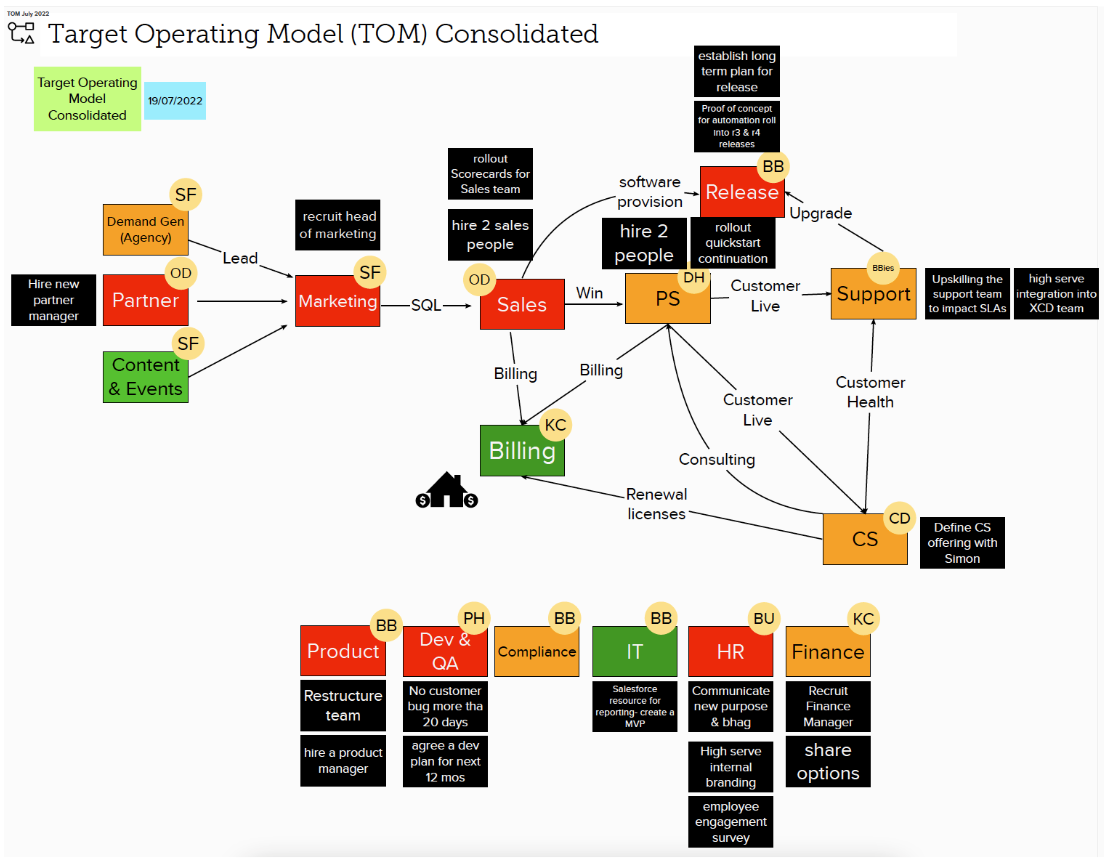You’re sitting in an endless Executive meeting. Every week it’s the same. Each team member feels compelled to report the status of their function at great length. And run through every KPI. Perhaps this justifies their existence, but is it really necessary? There must be a better way.
Let me introduce you to the Target Operating Model. This helpful tool will streamline discussions in your executive team meetings. Investing a small amount of time upfront will save many hours of unproductive and unfocused meeting time. And it will reassure the rest of the business that the management team are working on the right things. The things that matter.
What is a Target Operating Model?
The Target Operating Model amalgamates several ideas. At its heart is Michael Porter’s ‘Value Chain Analysis’ – a business management concept that looks at the company’s activities that generate value. It also draws from the Cash Acceleration Cycle, part of the Scaling Up methodology, and Shannon Susko‘s work on the Key Process Flow Map.
We use this tool when coaching our clients to help them understand the critical activities in their business. It takes all the processes and functions and maps them out through the customer journey lens. Typically these are Marketing, Sales, Delivery, Customer Success and Billing. Then there are the supporting functions such as HR, Product Development, IT and Finance which also need to be on the model. Working through each of these systematically, we define the metrics that can be used to track progress.
Establishing ownership
Once you’ve populated your model with the functions in your quote to cash process, you must establish ownership. This is critical. One person in the Executive team should own every function. Sometimes this is obvious and follows the org chart. But this isn’t always that clear. Take HR, for example. It often splits into Compliance, Recruitment and Learning & Development. These may need three different owners.
Some names will appear in more than one box. This stimulates productive conversation around the critical things to your customers and staff and who’s accountable for these things. Work through the things that cause the most friction in your business and make sure they’re allocated.
Working out the status of each function
Once you’ve identified the functions and allocated an owner, it’s time to decide on the status. Which of them is Red, Amber or Green? Historically, if you were the owner of Marketing, you’d turn up and present data that showed that your world was green. And, in most companies, the Finance person wouldn’t argue with this. There’s a feeling that everyone should stay in their swim lane or silo, and we shouldn’t throw rocks at one another.
But in this exercise, you get the whole team to RAG (Red, Amber or Green) each function. Does every team member agree that Marketing is green? This can make people feel uncomfortable as they’ve never felt exposed in this way before. But it’s important because it will give an accurate picture of what’s happening.
Once the status has been identified and agreed upon by the whole team, it’s time to prioritise. Whereas before, the focus may have been on everyone, now you can drill down to any red function. They are the priority for the team. Most importantly, don’t waste time talking about any green areas.
Identifying upstream issues

Above is an image of a ‘live’ Target Operating Model we recently worked on. The team had identified that Support was amber. When we worked through the chain of activities, we started to identify why there was a problem with Support.
The client was supporting customers who weren’t an ideal fit. And why was this? Because Sales had a target to sell. They were selling as much as possible and being less selective about the type of customer they sold to. Again, we asked why. Working back, the root cause was in Marketing. They weren’t delivering enough qualified opportunities. Support was amber because Marketing was red.
Before this exercise, the Support owner might have yet to realise this. They had no context to say, ‘I can’t make Support green until we solve the upstream problem’. The whole team needed to get its collective brains together to focus on solving the issue in Marketing. Instead of running through the status of every function, they needed to narrow down to concentrate on the health metrics in the most broken areas.
Identifying metrics to measure
A vital part of the Target Operating Model is identifying the widgets that flow from one function to another and then measuring these. For example, the metric between Marketing and Sales could be SQLs (Sales Qualified Leads). Over time, there will be a lagging indicator that you can work out first. Work out how many SQLs have been generated in the past to hit a certain level of revenue. Once you have this as a lagging indicator, you can project forward and use it to predict the number of SQLs you need for your revenue goals.
If you plan to bill £100 million next year, do you know what these indicators need to be for each of your functions? For Sales, it might be a certain number of signed orders; for Ops, it might be invoices sent, etc. Map out these numbers for every function.
Then you can break it down into the numbers needed annually, quarterly, monthly, weekly and even daily. Now Marketing will know they need to do 60 SQLs per month instead of the 20 they’re currently doing. You’re starting to build a business model that is more than a spreadsheet with a target revenue figure. As part of this, work out how your £100 million of projected revenue will break down. How much is new or recurring revenue, and how much churn do you expect?
Working out tactical actions
In the example given above, the black boxes are tactical actions or OKRs. These will come out of every meeting that discusses the Target Operating Model. So, in the next 90 days, what actions are needed to turn each function from red to amber or amber to green? Your team will leave with a focused list of things to do that will make a genuine difference to the running of your business.
After all, business is a team sport. For the first time, your Executive team will see the rules of the game they’re playing. They’ll be written in a way that everyone can understand. And it’s clear what the score should be.
Focusing on the things that matter
Once you’ve agreed on your Target Operating Model within the Executive team, it can be widely shared. Take it to your monthly town hall or All-Hands meetings. And say to everyone, ‘Guess what – we know this is broken, and this is what we’re going to do about it.’
Before, staff might mutter that management didn’t understand what was happening on the front line. Now, you can show that you do. Your view is the same as theirs. And this is what will happen in the next 90 days to fix the issues.
When our clients do this, they get hugely positive feedback. The honesty and transparency are refreshing and so well received by the rest of their staff. Finally, management has a grip on the business and focuses on the things that matter. Great stuff!
Written by business coach and leadership coaching expert Dominic Monkhouse. Contact him to schedule a call here. You can order your free copy of his book, Mind Your F**king Business here.

